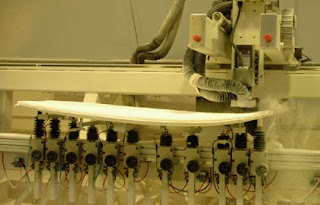Thecodont Thursday Surf & Culture Report
A good but overcast morning to you all! Almost drizzling. Let's check the stats and see what's going on...
Pretty thick fog bank going on at the beach, although minutes up the hill to the east it's clear as a bell. Visibility is 1 mile. Winds are blowing like a bat out of the SSW by 11.7kts and the sea surface is rife with choppy, unorganized tack. The air temp is 60.8° and the water has dropped precipitously to 61.3°. High tide is at 8:02am +3.2' and low tide will follow at 12:06pm +2.4'. The buoy is reading a 2.6' swell out of 210°. We're calling the surf 1' to 2' and poor. It might get better with a lowering tide, but you're going to have to find a spot out of the wind. Danger Boy and the Professor checked out the Cove trying to find a spot guarded enough from the wind to go out. But at 8am, the tide had even the bigger swells floating over the reef. Check it out in the pm.
Here's something you know more about (intuitively) than you thought: Reynolds Number
Definition
Reynolds number can be defined for a number of different situations where a fluid is in relative motion to a surface. These definitions generally include the fluid properties of density and viscosity, plus a velocity and a characteristic length or characteristic dimension. This dimension is a matter of convention - for example a radius or diameter are equally valid for spheres or circles, but one is chosen by convention. For aircraft or ships (or surfboards,) the length or width can be used. For flow in a pipe or a sphere moving in a fluid the internal diameter is generally used today. Other shapes (such as rectangular pipes or non-spherical objects) have an equivalent diameter defined. For fluids of variable density (e.g. compressible gases) or variable viscosity (non-Newtonian fluids) special rules apply. The velocity may also be a matter of convention in some circumstances, notably stirred vessels (and martinis.)
where:
 is the mean fluid velocity (SI units: m/s)
is the mean fluid velocity (SI units: m/s)- L is a length of the object that the flow is going through or around (m)
- μ is the dynamic viscosity of the fluid (Pa·s or N·s/m²)
- ν is the kinematic viscosity (ν = μ / ρ) (m²/s)
 is the density of the fluid (kg/m³)
is the density of the fluid (kg/m³)- Q is the volumetric flow rate (m³/s)
- A is the pipe cross-sectional area (m²)
"When the surf breaks, we'll fix it..."
The Professor!!





